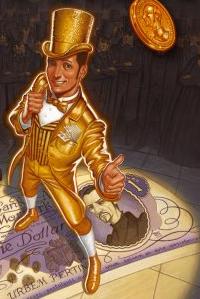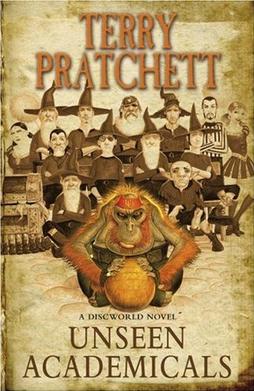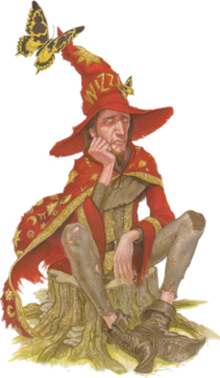
The Unseen University (UU) is a school of wizardry in Terry Pratchett's Discworld series of fantasy novels. Located in the fictional city of Ankh-Morpork, the UU is staffed by mostly indolent and inept old wizards. The university's name is a pun on the Invisible College, and many aspects of the university are references to Oxford and Cambridge University. The exploits of the head wizards of the Unseen University are one of the main plot threads in the long-running fantasy series, and have played a central role in 13 novels to date, as well as the four supplementary Science of Discworld novels and the short story, A Collegiate Casting-Out of Devilish Devices.

Jingo is a fantasy novel by British writer Terry Pratchett, part of his Discworld series. It was published in 1997.

The Last Continent is a fantasy novel by British writer Terry Pratchett, the twenty-second book in his Discworld series. First published in 1998, it mocks the aspects of time travel such as the grandfather paradox and the Ray Bradbury short story "A Sound of Thunder". It also parodies Australian people and aspects of Australian culture, such as Crocodile Dundee, The Adventures of Priscilla, Queen of the Desert and Mad Max films, the Australian beer XXXX, Vegemite, thongs, cork hats, the Peach Melba, Skippy the Bush Kangaroo, the bushranger Ned Kelly, the Henley-on-Todd Regatta, and the Australian songs "Waltzing Matilda", "Down Under", and "The Man From Snowy River".

Sourcery is a fantasy novel by British writer Terry Pratchett, the fifth book in his Discworld series, published in 1988.

The Colour of Magic is a 1983 fantasy comedy novel by Terry Pratchett, and is the first book of the Discworld series. The first printing of the British edition consisted of only 506 copies. Pratchett has described it as "an attempt to do for the classical fantasy universe what Blazing Saddles did for Westerns."

The Light Fantastic is a comic fantasy novel by Terry Pratchett, the second of the Discworld series. It was published on 2 June 1986, the first printing being of 1,034 copies. The title is taken from L'Allegro, a poem by John Milton, and refers to dancing lightly with extravagance.

Equal Rites is a comic fantasy novel by Terry Pratchett. Published in 1987, it is the third novel in the Discworld series and the first in which the main character is not Rincewind. The title is wordplay on the phrase "Equal Rights".

Guards! Guards! is a fantasy novel by British writer Terry Pratchett, the eighth in the Discworld series, first published in 1989. It is the first novel about the Ankh-Morpork City Watch. The first Discworld point-and-click adventure game borrowed heavily from the plot of Guards! Guards!

Eric, stylized as Faust Eric, is the ninth Discworld novel by Terry Pratchett. It was originally published in 1990 as a "Discworld story", in a larger format than the other novels and illustrated by Josh Kirby. It was later reissued as a normal paperback without any illustrations, and in some cases, with the title given on the cover and title pages simply as Eric.

Interesting Times is a fantasy novel by British writer Terry Pratchett, the seventeenth book in the Discworld series, set in the Aurient.

Men at Arms is a fantasy novel by British writer Terry Pratchett, the 15th book in the Discworld series, first published in 1993. It is the second novel about the Ankh-Morpork City Watch on the Discworld. Lance-constable Angua von Überwald, later in the series promoted to the rank of Sergeant, is introduced in this book. Lance-constable Detritus is introduced as a new member of the watch as well, though he had already appeared in other Discworld novels, most notably in Moving Pictures. Also notable is the only appearance of Lance-constable Cuddy.

Discworld II: Missing Presumed...!? is a 1996 point-and-click adventure game based on Terry Pratchett's series of fantasy novels set on the mythical Discworld, and sequel to the 1995 video game of the same name. The story sees players assume the role of Rincewind the "wizzard" as he becomes burdened with the task of finding Death and coercing him out of an impromptu retirement and back into his regular duties. The game's plot borrows from a number of Discworld books, including key elements from Reaper Man and Moving Pictures.

Discworld is a point-and-click adventure game developed by Teeny Weeny Games and Perfect 10 Productions and published by Psygnosis. It is based on Terry Pratchett's novels of the same name. Players assume the role of Rincewind the "wizzard", voiced by Eric Idle, as he becomes involved in exploring the Discworld for the means to prevent a dragon terrorising the city of Ankh-Morpork. The game's story borrows elements from several Discworld novels, with its central plot loosely based on the events in Guards! Guards!

Moist von Lipwig is a fictional character from Terry Pratchett's Discworld series. A "reformed con-man" who is one of the major characters of the series, von Lipwig is the protagonist of the novels Going Postal, Making Money, and Raising Steam.

The Discworld is the fictional setting for all of Terry Pratchett's Discworld fantasy novels. It consists of a large disc resting on the backs of four huge elephants which are in turn standing on the back of an enormous turtle, named Great A'Tuin as it slowly swims through space. The Disc has been shown to be heavily influenced by magic and, while Pratchett gave it certain similarities to planet Earth, he also created his own system of physics for it.

Terry Pratchett's The Colour of Magic is a fantasy-comedy two-part British television adaptation of the bestselling novels The Colour of Magic (1983) and The Light Fantastic (1986) by Terry Pratchett. The fantasy film was produced for Sky1 by The Mob, a small British studio, starring David Jason, Sean Astin, Tim Curry, and Christopher Lee as the voice of Death. Vadim Jean both adapted the screenplay from Pratchett's original novels, and served as director.

Ankh-Morpork is a fictional city-state the setting for many Discworld novels by Terry Pratchett.

Unseen Academicals is the 37th novel in Terry Pratchett's Discworld series. The novel satirises football, and features Mustrum Ridcully setting up an Unseen University football team, with the Librarian in goal. It includes new details about "below stairs" life at the university. The book introduces several new characters, including Trevor Likely, a street urchin with a wonderful talent for kicking a tin can; Glenda Sugarbean, a maker of "jolly good" pies; Juliet Stollop, a dim but beautiful young woman who might just turn out to be the greatest fashion model there has ever been; and the mysterious Mr Nutt, a cultured, enigmatic, idealistic savant. According to the publisher, Transworld, the "on sale" date for the hardback was 1 October 2009 although the official publication date is 8 October 2009. Bookshop chain Borders included a small set of exclusive Discworld football cards with each book.

Discworld is a comic fantasy book series written by the English author Terry Pratchett, set on the Discworld, a flat planet balanced on the backs of four elephants which in turn stand on the back of a giant turtle. The series began in 1983 with The Colour of Magic and continued until the final novel The Shepherd's Crown, which was published in 2015, following Pratchett's death. The books frequently parody or take inspiration from classic works, usually fantasy or science fiction, as well as mythology, folklore and fairy tales, and often use them for satirical parallels with cultural, political and scientific issues.


















